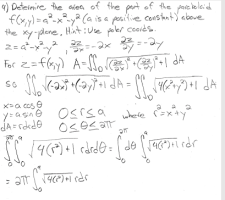Hckyplayer8
Full Member
- Joined
- Jun 9, 2019
- Messages
- 269
Hello. I was working on this problem and got stuck after converting the integral to polar coordinates and integrating theta. Because the function converts to r^2
the integral becomes

My question involves the next step which tells me to assume 1+4r2=t
My question is, why? Is this just an arbitrary variable that just so happens to be t? Or does it mean more?

